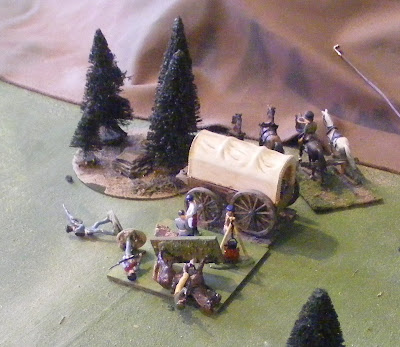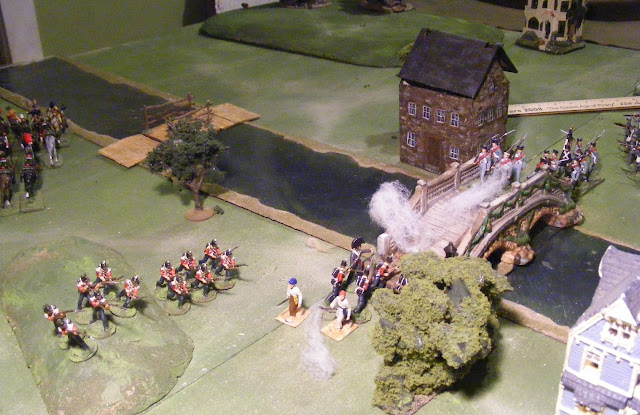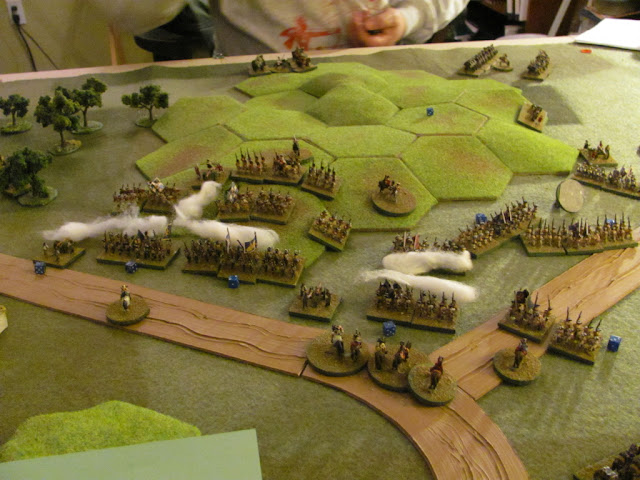Prologue
This is the last of this year's battles (
though there may yet be time to refight it as a Rough Wooing game before the year ends). As such it seems a good time to reflect a bit more on past, present and future as well as musing a bit more about the theory and philosophy behind my future games and so forth. Luckily for all of us, I'm going to put that off into another post. Instead, let me just set the scene a little. Time & energy was short but the desire to play was long. The decision still stands to cast off imaginary lands, and cut back on strictly historical campaigns, both things which make these encounters oh so much easier to stage, the one allowing full rein to the imagination, the other hardly needing any. Instead, once again, my 1840's British and American forces meet at an undefined if not improbable location, this time one where converging trade routes have resulted in a thriving settlement near 3 bridges which have been thrown across the Hard River within rifle shot of each other in the middle of a land, otherwise nearly empty. (
This is as good a point as any to mention that while students of the Great Wars of Empire where 100,000 men may clash in a single battle may smirk at the use of "battle" to describe an encounter between less than 2,000 men a side, on the fringes of Empire, such small engagements have affected the fate of nations)
The battle gets underway, the first cavalry clash is over, the 2nd is about to begin. At the far end of the table, the 26th Foot has just thrown back the Volunteer Rifles. (and yes this is a repeat of yesterday's shot)
Set Up
In one of those ironies that can arise when both sides are of the same race, both forces were commanded by a General Ross (
the forthcoming campaign hasn't evolved to the point of establishing all of the personalities yet and somehow carrying over personal names from an imaginary land just didn't seem right). Names then shall be forgotten and the labels Red General and Blue General applied for the day.
The two forces involved are approaching the vital area unaware of the presence of the other due to an accident in terrain (
and presumably a failure to scout ahead). All units are 5 "companies" strong. The regular infantry having 4 figures/hits per company, the irregulars and cavalry 2. The rules of course, Hearts of Tin.
To the north of the river, Red's forces appeared from behind a patch of woods, Larsen's Lancer's in the lead. This is a Regular Cavalry unit originally recruited as Irregulars in India. The locally recruited Voltigeurs, a unit of irregular skirmishers, follows then the 26th Foot, transferred from India to China and now across the Pacific to the North-West. Due to their long journey and unfamiliarity with the country or perhaps due to wargaming etiquette, these have not been classed as veteran. An experimental observation balloon wagon pulled by an even more experimental steam tractor followed and last but not least, the Fencibles, a unit of Canadian Incorporated militia who have volunteered for foreign service.
South of the river, Blue's forces appeared from the mouth of an off table mountain pass. First the Frontier Light Horse, a somewhat problematic unit who began life as a sort of Cape Mounted Rifles but gained some Texas Ranger-y type recruits and switched sides. They are obviously a somewhat irregular looking unit but with a history of being deployed as ordinary light cavalry and I'm not exactly sure yet exactly how to treat them or if they can keep their name or indeed of its possible for me to change it successfully. So for now they are fierce if ragged regular light cavalry. Behind them was a unit of Volunteer (militia) Rifles then the 1st Infantry, a field hospital, and bringing up the rear, the 2nd Infantry.
The Battle
Both sides pressed on to the table with me pretending that they don't yet know of the other and assuming orders to cross the middle bridge. I decided not to go with the written orders option but may try it next game as there were some instances of very alert subordinates showing laudable initiative during the game. Once the enemy was spotted, I made some spot checks for the initial reactions, you know the sort of thing, 5,6 make a suicidal charge over the bridge, 1,2,3,4 deploy to defend etc, what ever options seemed reasonable in the circumstance. The result was that the Frontier horse sent 2 troops galloping (
ok walking verrrry slowly, not often a unit rolls a total of 7" on 5 dice) down to the far bridge while the rest deployed to watch the main one. The Lancers who had actually arrived first, decided to match this deployment while the Voltigeurs deployed behind the first wooden bridge and opened fire only to find that their muskets wouldn't reach. Oops. (
Well the river had been originally constructed for a Charge! game and was meant to prevent close range musket fire exchanges.) Luckily for play balance, it seems that the Voltigeurs are such good shots that they could be treated as being rifled armed anyway (
Yes, a fudge, the matter has been referred to a committee for resolution prior to the start of any "serious" campaigning).
The light horse, seeing the opposition close on the other end, finally spurred their horses forward and charged over the bridge. A tied melee sent both sides rallying back to their respective sides while the rest of the cavalry on both sides spurred to reinforce and infantry took over the main bridge. Another swirling melee saw Larsen's Lancers driven back but the Light Horse declined to risk pursuit and an uneasy truce reigned as the 2 sides eyed each other on the North bank of the river.
Back to the west, the 2 special units deployed, the balloon ascended, noted carefully the location and direction of march of enemy units and sent down the information only to find that the Red General had taken post at the head of the 26th Foot and advanced out of communication range. Governor Lawrence, acting as observer, began making notes for his private journal. Across the river, Dr. Pierce had begun operating and a slow trickle of wounded figures was soon heading back to their units. (
hmmmm)
A busy day at the field hospital. The figures on the base will be rolled for at the end of the turn. Those just off the base have just arrived and will be "treated" next turn.
As the British regulars arrived, the Red General decided to go on the offensive. It looked like a straight forward affair, British regulars with bayonets against volunteer skirmishers. A quick charge by 3 companies and the 1st bridge would be in British hands. It seemed unlikely that the enemy would stand but there was some confusion (
ie low movement dice) and the Red General had to ride over and bellow "Follow me Brave Lads" and spur across the bridge. Since the skirmishers only get 1 die per stand vs 2 dice for the regulars, an evade seemed like the rational response but the regulars were coming across a narrow defile and only 3 companies at that, so I diced for it and the Volunteer's Colonel decided to stand and fight.
Once I started counting up dice, it suddenly looked like a good decision. One die per stand for the volunteers gave them 5 dice albeit with a -1 for being Militia grade. The single company of line infantry were worth 2 dice but the 2 supporting companies only offered 1 apiece with the general's die bringing it up to 5 nearly an even match but slightly in the regular's favour. Slightly wasn't good enough and the Volunteers managed to tie the melee 3 rounds in a row while the 2nd Infantry came up and deployed behind them. When the Volunteers finally broke off, the 2nd Infantry easily drove the tired remnant of the 26th back across the bridge.
The 26th Foot retreats.
This of course put the General within reach of the balloon's report (
or in game terms, if within 12" at the start of a turn, the balloon warrants a +1 to his initiative roll). Unfortunately, it seems to have taken him so long to read the reports each turn that +1 wasn't enough and the British did not win a single initiative for the rest of the game!
The battle had not stood still during this struggle. The Fencibles had been given what turned out to be a critical order, to dispatch 3 companies to support the cavalry while 2 companies supported by Voltigeurs held the main bridge exits. With the cavalry clash in doubt and the initial British assault repulsed, it was now or never. The Blue General ordered the 1st Infantry to storm the middle bridge leaving one company to garrison the Stone House. Again the irregulars were able to hold the defile for several turns before losses took their toll (
they were losing a company and thus a die for each 2 casualties but needed to inflict 4 hits to do the same to the enemy). Eventually, numbers told and the remaining Voltigeurs were compelled to fall back and the Fencibles stepped into the gap. An attempt by the the 1st Infantry to break through was easily repulsed and the remaining companies eyed each other warily across the bridge and awaited events elsewhere.
A wing of the Fencibles hold the bridge while the rest retrace their steps and head for the crisis point
Seeing the approach of supports, Colonel Larsen threw his lancers forward and eventually drove off the enemy cavalry. By the end of the affair, however, his own men and horses were exhausted and could only sit and watched as 3 companies of enemy Rifles, many of them with bandages about their heads, arrived to take post across the river.
Stalemate threatened, the Blue General spurred to the head of the 2nd Infantry and led them in a charge across the near bridge. This sent the disorganized 26th fleeing further back until their officers could rally the remnants on the 2 companies that had been left behind. Sensing victory, the Americans gave pursuit, crashing into a company of Voltiguers which had been detached as a backstop of the bridge approaches as well as a 2nd company garrisoning the small town at the foot of the bridge. Sensing the desperate moment, the Red general spurred forward to join the Voltigeurs but was immediately struck by a bullet (
rolled a 1) and was then taken prisoner as the Voltigeurs in the open dispersed. The men finding cover in town were made of sterner stuff and it was now the turn of the Americans to try to force their way out of the defile. (
the 3" melee rule meant they couldn't just bypass it.)
Bird's eye view of the American charge.
While the fight raged, the 2nd in Command had taken over and gathered his men, 3 companies of unengaged Fencibles, forced march back from the far bridge due to the initiative of their Colonel, the remnants of the 26th, one company of Voltigeurs and himself. Both armies were nearing exhaustion, the next fight would settle it. As the Americans finally broke into the town, he led his men forward. The defender's volley rang out and the 26th lost a full company, the Fencibles in column, crashed through a gap and into the American line but the enemy was unimpressed (ok so the sight of three 1's and a 2 impressed them a little bit). However, the Blue General had also rolled a 1 and was struck down. The Voltigeurs who had infiltrated into the town again, rolled a hit, the Red 2ic rolled, 1!, he also went down like MacDonnell at Queenston Heights, Two companies of the 26th, remained, the melee stood at 4 hits ve 1 against them, they needed to roll 4,5 or 6 on each of their 4 dice to turn the tide of battle. Who needs veteran status with dice like that, 3 5's and a 6! With a hurrah they pressed forward in pursuit and sent the 2nd Infantry skedadling into the hills, covered by the remnants of the little force. (S
uggestions that the Colonel had time to receive a report from the balloon that the enemy needed to lose 1 more company to break their morale before deciding to pursue are widely dismissed).
An artist's rendering of the final pursuit. He seems to have made a slight error though and shows the Fencibles in pursuit instead of the 26th. The Fencibles, of course, having suffered more hits than they inflicted, had been repulsed.
The District Commander is now contemplating alternate uses for the balloon while sending out orders to recruit a field hospital. The added resilience that the hospital bestowed had kept the Americans above their breaking point for an extra turn or two and almost allowed them to snatch the victory while the +1 from the Observation Balloon was entirely wasted. True, twice it turned an American win into a tie but since the US had gone first on the preceding turn and wanted to again, no benefit was gained.
On the whole, a small but satisfying game. Some reflections on the game, the rules, game/scenario design and the upcoming year to follow in a few days.
"Could you tell us your name sir?"












































